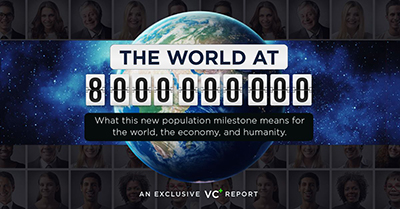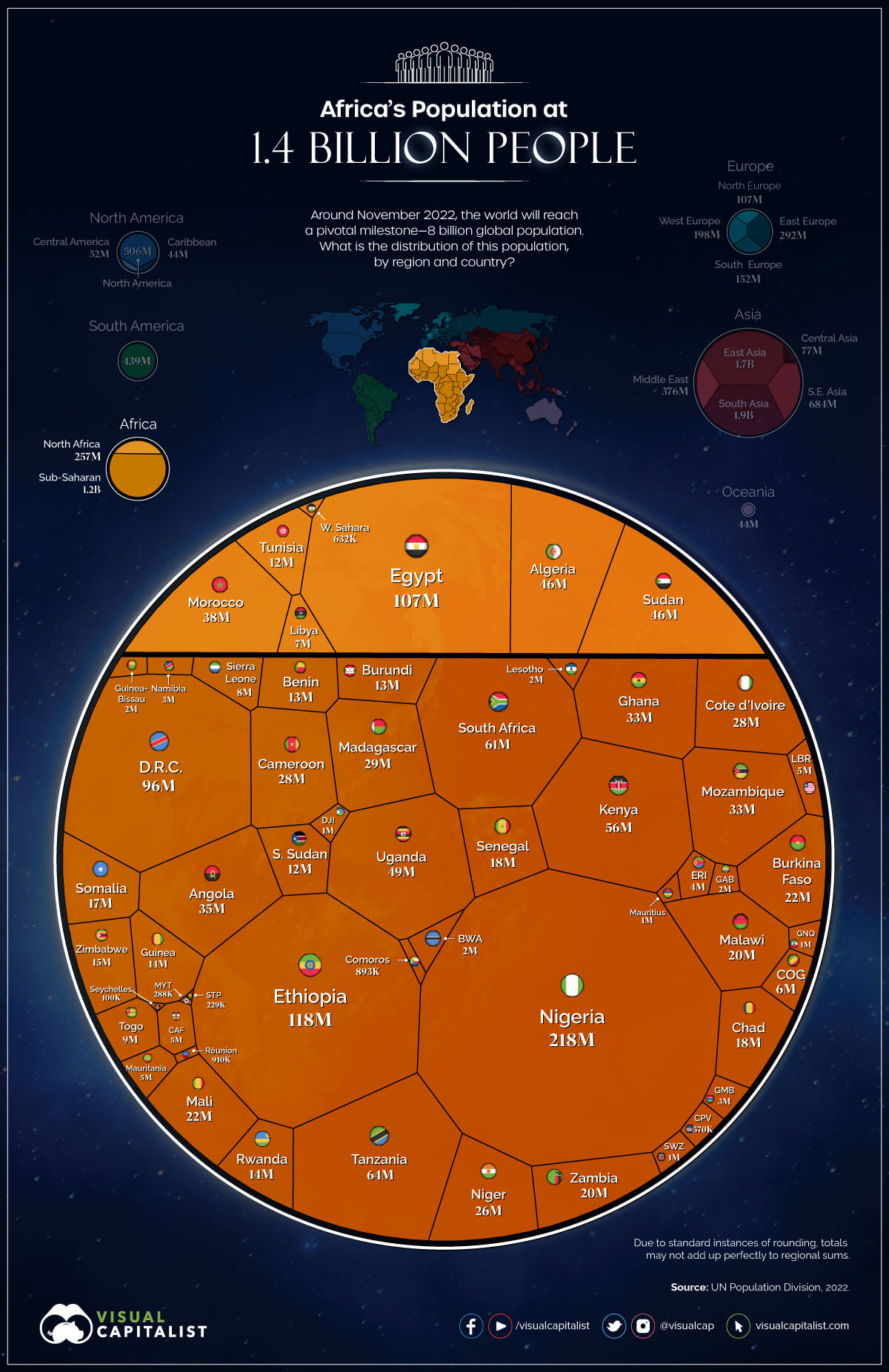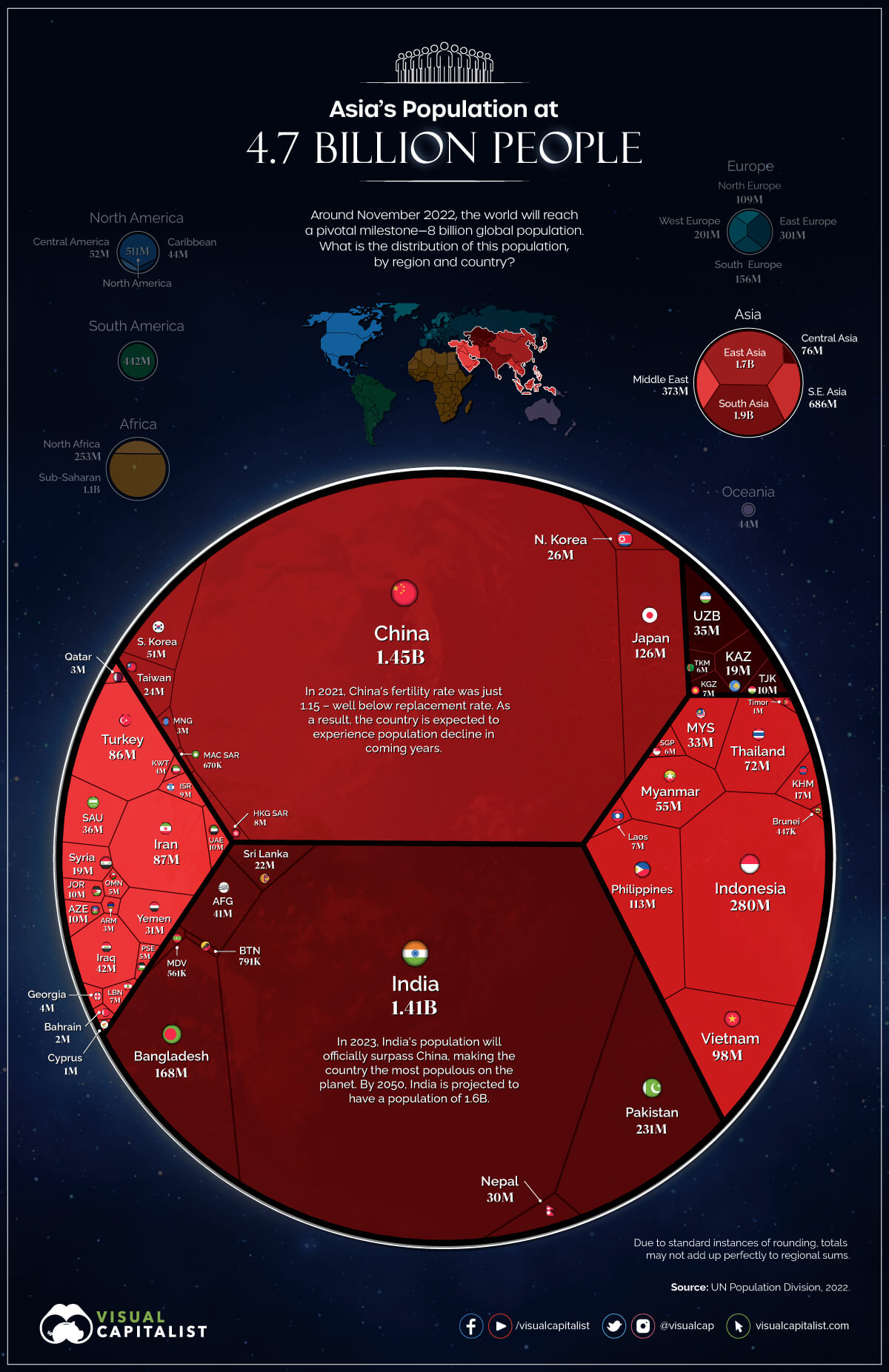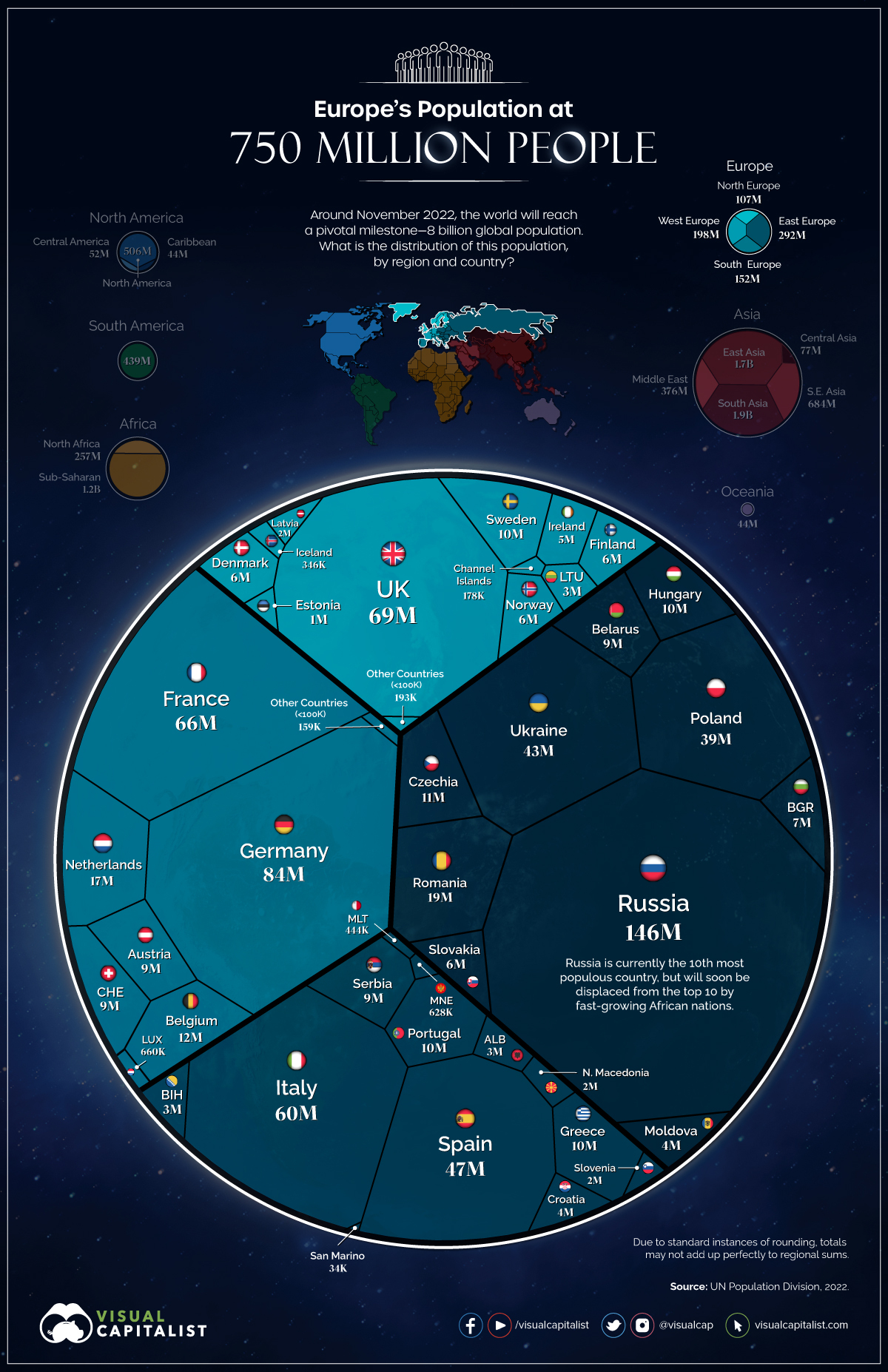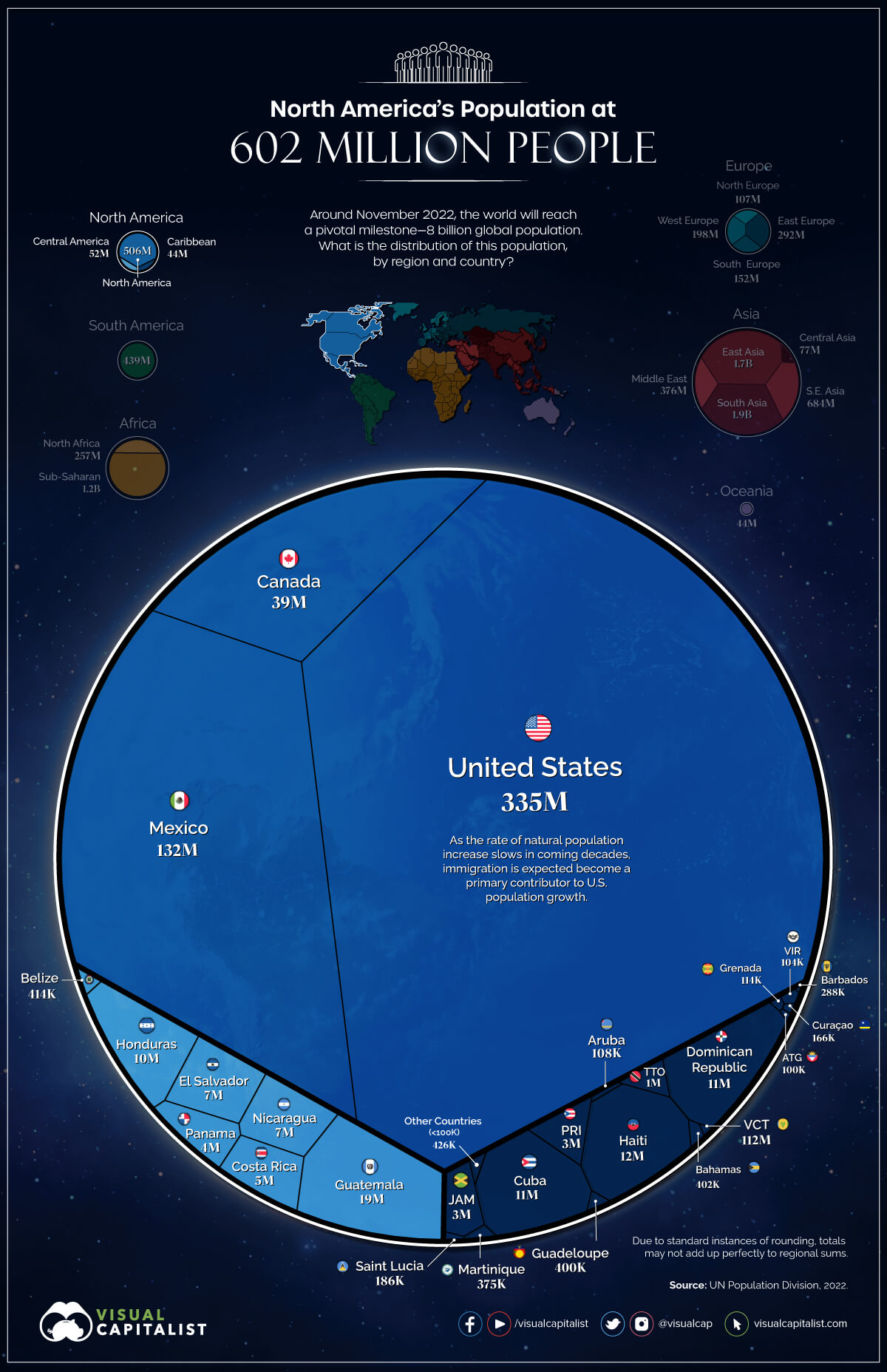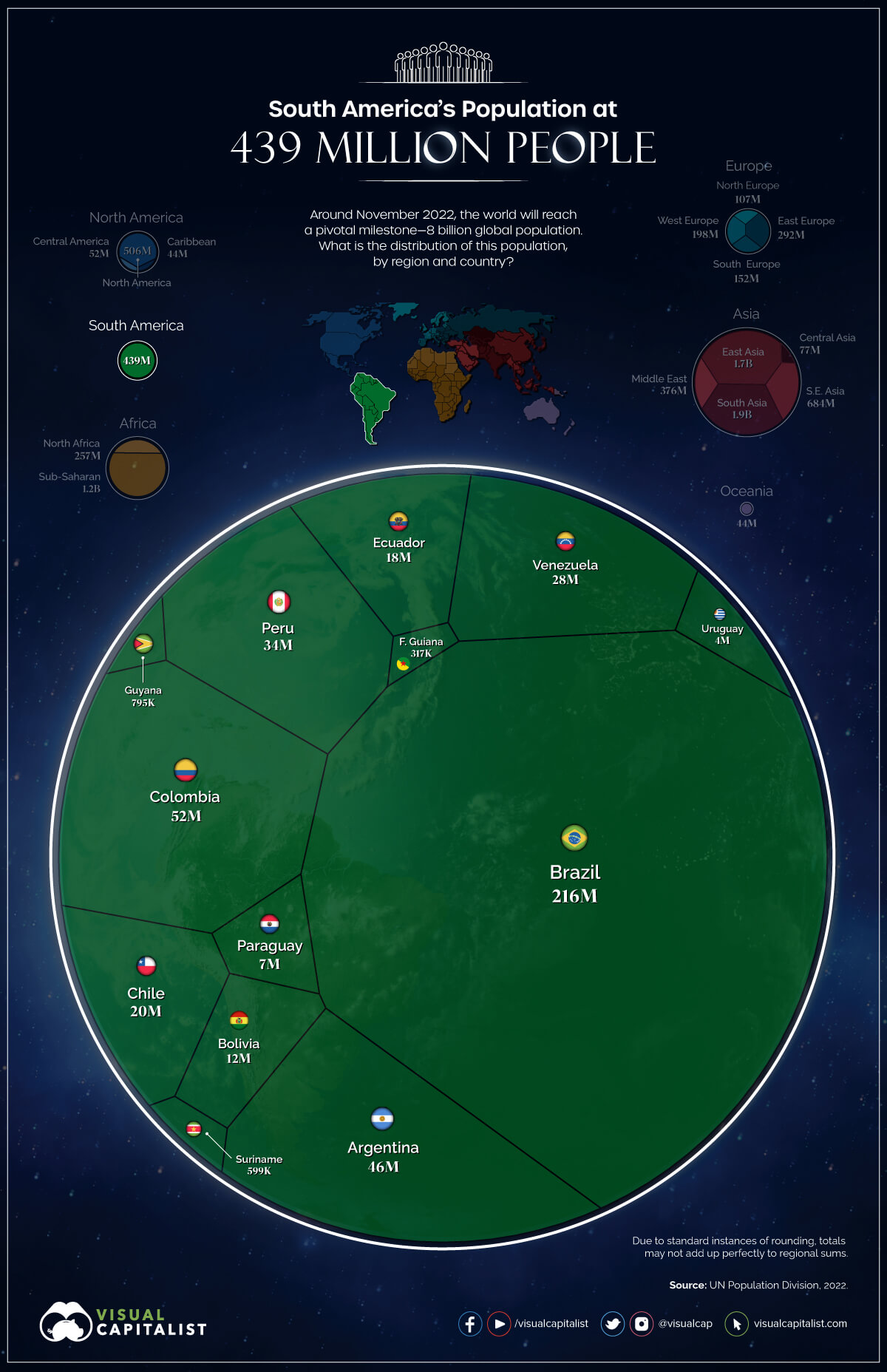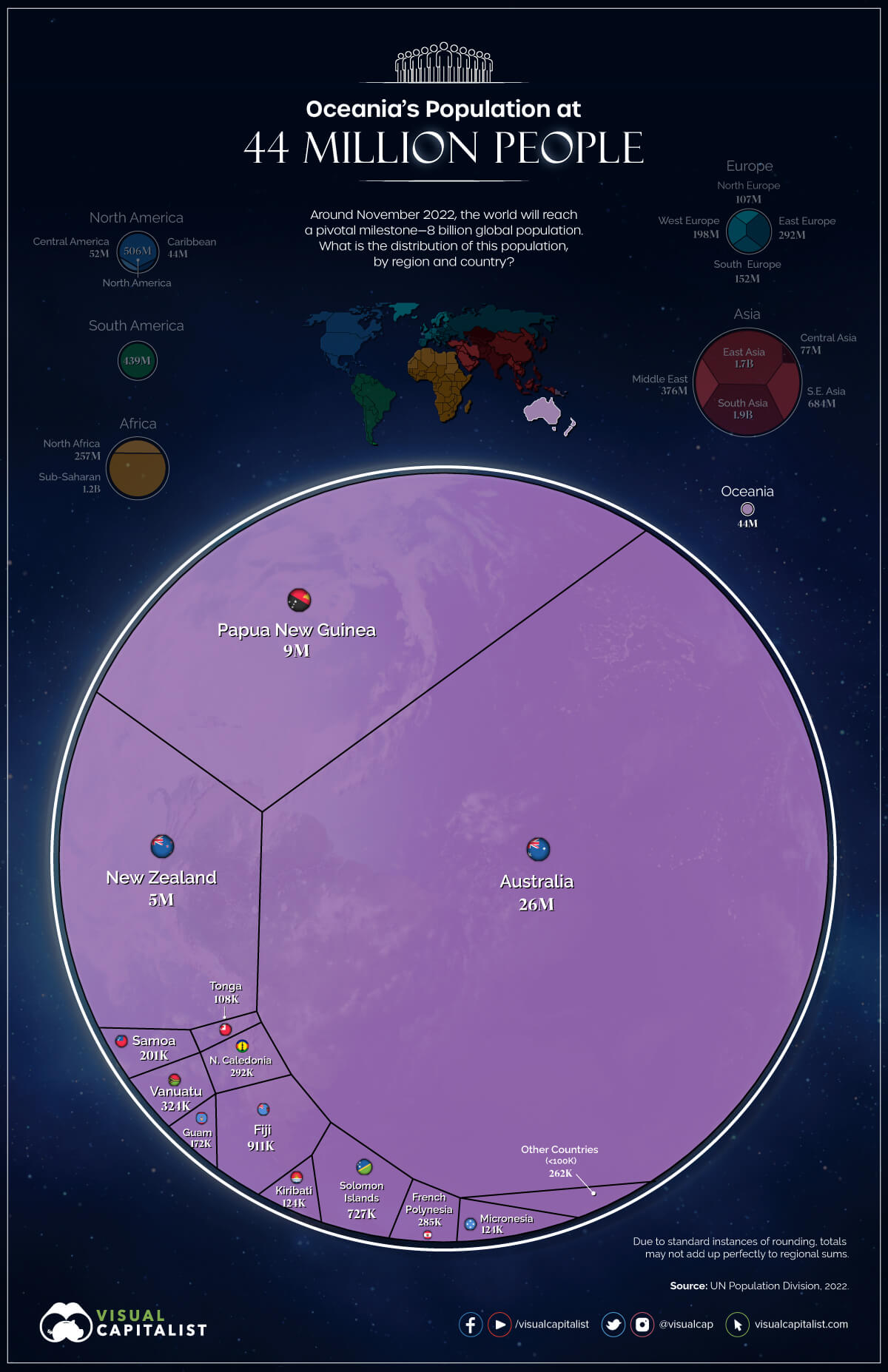Markets
Visualized: The World’s Population at 8 Billion
VC+ members get access to our World at 8 Billion Report.
Gain access to this exclusive new report and webinar by becoming a VC+ member.
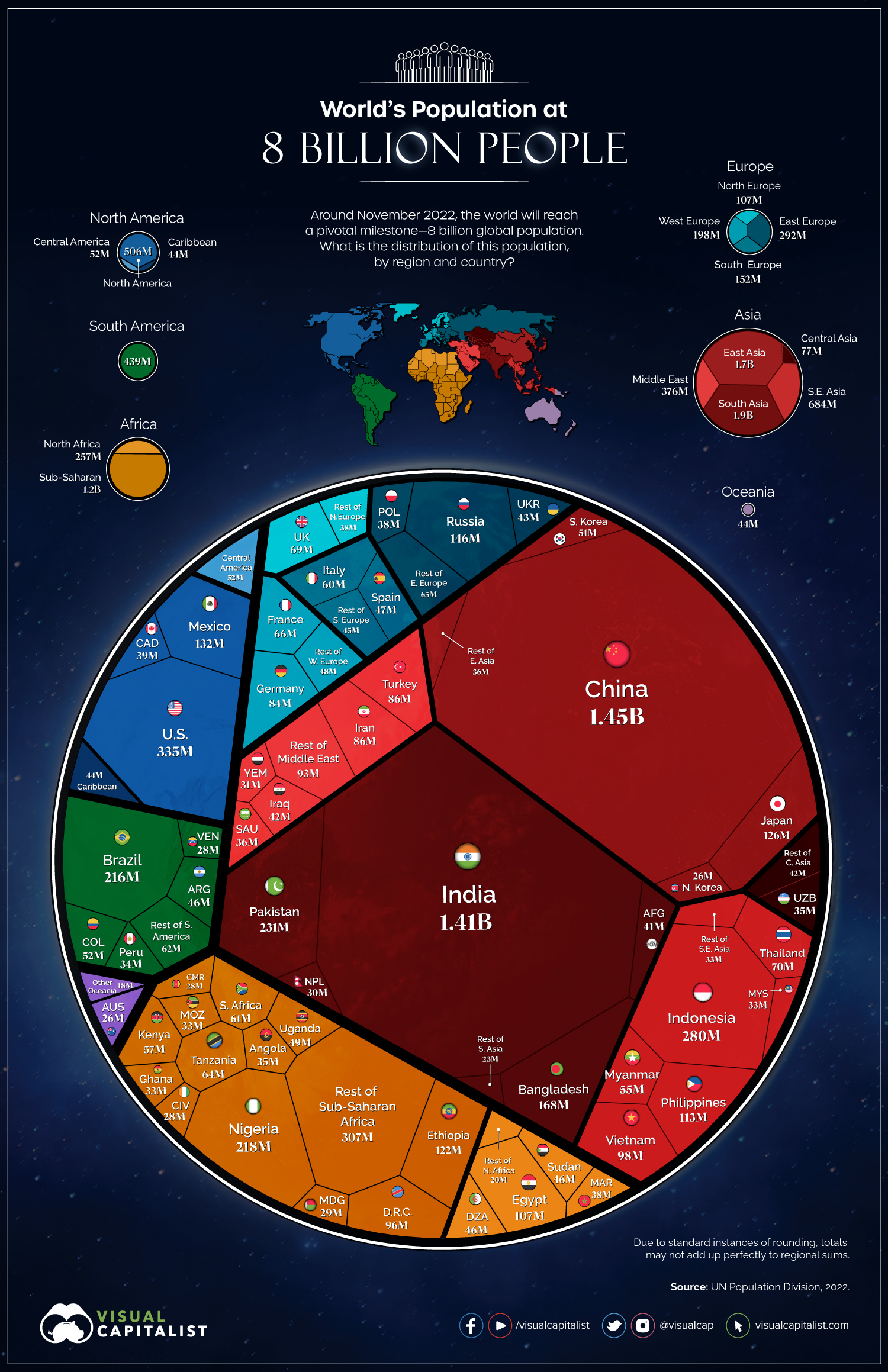
Visualized: The World’s Population at 8 Billion
At some point in late 2022, the eight billionth human being will enter the world, ushering in a new milestone for humanity.
In just 48 years, the world population has doubled in size, jumping from four to eight billion. Of course, humans are not equally spread throughout the planet, and countries take all shapes and sizes. The visualizations in this article aim to build context on how the eight billion people are distributed around the world.
For extended coverage of this moment and what it means to the world, you can get access to our full report and webinar by signing up to VC+, our premium newsletter.
Now, here’s a look at each country’s population as of September 2022:
| Global Rank | Country/Region | Population (2022) |
|---|---|---|
| 1 | 🇨🇳 China | 1,451,832,064 |
| 2 | 🇮🇳 India | 1,410,982,243 |
| 3 | 🇺🇸 United States | 335,391,957 |
| 4 | 🇮🇩 Indonesia | 280,139,383 |
| 5 | 🇵🇰 Pakistan | 230,918,073 |
| 6 | 🇳🇬 Nigeria | 218,243,241 |
| 7 | 🇧🇷 Brazil | 215,986,577 |
| 8 | 🇧🇩 Bangladesh | 168,436,792 |
| 9 | 🇷🇺 Russia | 146,074,130 |
| 10 | 🇲🇽 Mexico | 132,030,739 |
| 11 | Japan | 125,619,457 |
| 12 | Ethiopia | 121,709,461 |
| 13 | Philippines | 112,939,493 |
| 14 | Egypt | 106,839,825 |
| 15 | Vietnam | 98,311,965 |
| 16 | Democratic Republic of Congo | 96,104,525 |
| 17 | Iran | 86,465,398 |
| 16 | Turkey | 86,415,852 |
| 19 | Germany | 84,385,892 |
| 20 | Thailand | 70,192,866 |
| 21 | United Kingdom | 68,691,253 |
| 22 | France | 65,597,276 |
| 23 | Tanzania | 63,802,882 |
| 24 | South Africa | 61,027,608 |
| 25 | Italy | 60,264,287 |
| 26 | Kenya | 56,557,929 |
| 27 | Myanmar | 55,236,333 |
| 28 | Colombia | 52,123,686 |
| 29 | South Korea | 51,367,770 |
| 30 | Uganda | 49,222,889 |
| 31 | Spain | 46,795,195 |
| 32 | Sudan | 46,265,964 |
| 33 | Argentina | 46,141,195 |
| 34 | Algeria | 45,695,757 |
| 35 | Ukraine | 43,156,242 |
| 36 | Iraq | 42,348,230 |
| 37 | Afghanistan | 40,993,541 |
| 38 | Canada | 38,495,773 |
| 39 | Morocco | 37,914,397 |
| 40 | Poland | 37,754,428 |
| 41 | Saudi Arabia | 36,069,266 |
| 42 | Angola | 35,327,540 |
| 43 | Uzbekistan | 34,589,376 |
| 44 | Peru | 34,031,086 |
| 45 | Mozambique | 33,346,961 |
| 46 | Malaysia | 33,319,730 |
| 47 | Ghana | 32,594,574 |
| 48 | Yemen | 31,371,445 |
| 49 | Nepal | 30,357,476 |
| 50 | Madagascar | 29,381,411 |
| 51 | Venezuela | 28,257,503 |
| 52 | Cameroon | 28,111,718 |
| 53 | Cote d'Ivoire | 27,925,649 |
| 54 | Niger | 26,344,186 |
| 55 | Australia | 26,178,342 |
| 56 | North Korea | 26,033,387 |
| 57 | Taiwan | 23,913,311 |
| 58 | Burkina Faso | 22,270,251 |
| 59 | Mali | 21,646,251 |
| 60 | Sri Lanka | 21,615,470 |
| 61 | Malawi | 20,304,147 |
| 62 | Chile | 19,489,734 |
| 63 | Zambia | 19,613,655 |
| 64 | Kazakhstan | 19,292,183 |
| 65 | Romania | 18,956,053 |
| 66 | Guatemala | 18,688,479 |
| 67 | Syria | 18,506,569 |
| 68 | Ecuador | 18,262,799 |
| 69 | Senegal | 17,793,385 |
| 70 | Chad | 17,553,601 |
| 71 | Cambodia | 17,252,457 |
| 72 | Netherlands | 17,219,859 |
| 73 | Somalia | 16,951,984 |
| 74 | Zimbabwe | 15,362,663 |
| 75 | Guinea | 13,981,705 |
| 76 | Rwanda | 13,712,855 |
| 77 | Benin | 12,878,142 |
| 78 | Burundi | 12,740,471 |
| 79 | Tunisia | 12,101,418 |
| 80 | Bolivia | 12,039,974 |
| 81 | Haiti | 11,721,737 |
| 82 | Belgium | 11,703,272 |
| 83 | South Sudan | 11,494,756 |
| 84 | Cuba | 11,311,223 |
| 85 | Dominican Republic | 11,096,411 |
| 86 | Czechia | 10,753,478 |
| 87 | Jordan | 10,434,463 |
| 88 | Azerbaijan | 10,347,430 |
| 89 | Greece | 10,310,847 |
| 90 | Honduras | 10,269,662 |
| 91 | Sweden | 10,241,804 |
| 92 | United Arab Emirates | 10,164,747 |
| 93 | Portugal | 10,130,876 |
| 94 | Hungary | 9,605,987 |
| 95 | Tajikistan | 10,042,202 |
| 96 | Belarus | 9,442,398 |
| 97 | Papua New Guinea | 9,342,727 |
| 98 | Austria | 9,122,566 |
| 99 | Israel | 8,969,013 |
| 100 | Switzerland | 8,798,256 |
| 101 | Togo | 8,737,152 |
| 102 | Serbia | 8,659,648 |
| 103 | Sierra Leone | 8,357,040 |
| 104 | Hong Kong SAR | 7,635,279 |
| 105 | Laos | 7,519,384 |
| 106 | Paraguay | 7,333,782 |
| 107 | Libya | 7,086,602 |
| 108 | Bulgaria | 6,833,885 |
| 109 | Nicaragua | 6,805,420 |
| 110 | Kyrgyzstan | 6,774,001 |
| 111 | Lebanon | 6,758,016 |
| 112 | El Salvador | 6,560,071 |
| 113 | Turkmenistan | 6,236,038 |
| 114 | Singapore | 5,954,898 |
| 115 | Congo | 5,839,721 |
| 116 | Denmark | 5,838,070 |
| 117 | Finland | 5,559,984 |
| 118 | Norway | 5,517,561 |
| 119 | Slovakia | 5,465,545 |
| 120 | Oman | 5,414,812 |
| 121 | Palestine | 5,381,277 |
| 122 | Liberia | 5,338,398 |
| 123 | Costa Rica | 5,200,150 |
| 124 | Ireland | 5,064,136 |
| 125 | Central African Republic | 5,025,077 |
| 126 | Mauritania | 4,940,298 |
| 127 | New Zealand | 4,911,293 |
| 128 | Panama | 4,472,108 |
| 129 | Kuwait | 4,416,533 |
| 130 | Croatia | 4,049,640 |
| 131 | Moldova | 4,013,174 |
| 132 | Georgia | 3,972,171 |
| 133 | Eritrea | 3,659,593 |
| 134 | Uruguay | 3,500,798 |
| 135 | Mongolia | 3,400,693 |
| 136 | Bosnia and Herzegovina | 3,235,985 |
| 137 | Armenia | 2,975,648 |
| 138 | Qatar | 2,994,073 |
| 139 | Jamaica | 2,990,290 |
| 140 | Albania | 2,870,809 |
| 141 | Puerto Rico | 2,704,519 |
| 142 | Namibia | 2,648,122 |
| 143 | Lithuania | 2,640,339 |
| 144 | Gambia | 2,578,866 |
| 145 | Botswana | 2,462,832 |
| 146 | Gabon | 2,349,783 |
| 147 | Lesotho | 2,180,846 |
| 148 | North Macedonia | 2,083,183 |
| 149 | Slovenia | 2,079,575 |
| 150 | Guinea-Bissau | 2,077,878 |
| 151 | Bahrain | 1,845,321 |
| 152 | Latvia | 1,840,901 |
| 153 | Equatorial Guinea | 1,514,454 |
| 154 | Trinidad and Tobago | 1,409,672 |
| 155 | Timor | 1,377,091 |
| 156 | Estonia | 1,328,527 |
| 157 | Mauritius | 1,276,493 |
| 158 | Cyprus | 1,227,303 |
| 159 | Eswatini | 1,187,627 |
| 160 | Djibouti | 1,021,185 |
| 161 | Comoros | 913,105 |
| 162 | Fiji | 911,185 |
| 163 | Réunion | 909,806 |
| 164 | Guyana | 795,114 |
| 165 | Bhutan | 791,064 |
| 166 | Solomon Islands | 726,764 |
| 167 | Macao SAR | 669,734 |
| 168 | Luxembourg | 649,600 |
| 169 | Montenegro | 628,243 |
| 170 | Western Sahara | 632,115 |
| 171 | Suriname | 598,608 |
| 172 | Cape Verde | 569,810 |
| 173 | Micronesia (Fed. States of) | 561,300 |
| 174 | Maldives | 561,291 |
| 175 | Brunei | 447,038 |
| 176 | Malta | 444,182 |
| 177 | Belize | 414,449 |
| 178 | Bahamas | 401,818 |
| 179 | Guadeloupe | 400,277 |
| 180 | Martinique | 374,617 |
| 181 | Iceland | 346,259 |
| 182 | Vanuatu | 324,088 |
| 183 | French Guiana | 317,076 |
| 184 | New Caledonia | 291,762 |
| 185 | Mayotte | 288,384 |
| 186 | Barbados | 288,162 |
| 187 | French Polynesia | 284,580 |
| 188 | Sao Tome and Principe | 228,652 |
| 189 | Samoa | 201,401 |
| 190 | Saint Lucia | 185,519 |
| 191 | Channel Islands | 177,517 |
| 192 | Guam | 172,146 |
| 193 | Curaçao | 165,604 |
| 194 | Kiribati | 123,690 |
| 195 | Grenada | 113,966 |
| 196 | Saint Vincent and the Grenadines | 111,732 |
| 197 | Tonga | 108,440 |
| 198 | Aruba | 107,787 |
| 199 | United States Virgin Islands | 104,083 |
| 200 | Antigua and Barbuda | 99,773 |
| 201 | Seychelles | 99,725 |
| 202 | Isle of Man | 86,049 |
| 203 | Andorra | 77,542 |
| 204 | Dominica | 72,387 |
| 205 | Cayman Islands | 67,492 |
| 206 | Bermuda | 61,769 |
| 207 | Marshall Islands | 60,095 |
| 208 | Northern Mariana Islands | 58,336 |
| 209 | Greenland | 56,991 |
| 210 | American Samoa | 54,920 |
| 211 | Saint Kitts and Nevis | 54,052 |
| 212 | Faeroe Islands | 49,281 |
| 213 | Sint Maarten | 43,991 |
| 214 | Turks and Caicos | 39,924 |
| 215 | Monaco | 39,873 |
| 216 | Saint Martin | 40,198 |
| 217 | Liechtenstein | 38,374 |
| 218 | San Marino | 34,091 |
| 219 | Gibraltar | 33,669 |
| 220 | British Virgin Islands | 30,687 |
| 221 | Caribbean Netherlands | 26,779 |
| 222 | Palau | 18,288 |
| 223 | Cook Islands | 17,600 |
| 224 | Anguilla | 15,308 |
| 225 | Tuvalu | 12,126 |
| 226 | Nauru | 10,978 |
| 227 | Wallis and Futuna | 10,818 |
| 228 | Saint Barthelemy | 9,945 |
| 229 | Saint Helena | 6,118 |
| 230 | Saint Pierre & Miquelon | 5,732 |
| 231 | Montserrat | 4,999 |
| 232 | Falkland Islands | 3,723 |
| 233 | Niue | 1,651 |
| 234 | Tokelau | 1,396 |
| 235 | Holy See | 806 |
Below are regional breakdowns of population.
Africa’s Population by Country
As of 2022, Africa’s total population stands at 1.4 billion people. Many of the countries with the fastest growth rates are located in Africa and by 2050, the population of the continent is expected to jump to 2.5 billion.
Nigeria is Africa’s most populous country and its largest economy. Based on current growth rates, Nigeria’s largest city, Lagos, could even emerge as the world’s top megacity by the end of the century.
Africa has by far the lowest median age of any of the other continents.
Asia’s Population by Country
With 4.7 billion people in 2022, Asia is by far the world’s most populous region.
The continent is dominated by the two massive population centers of China and India. In 2023, a big shift will occur, with India surpassing China to become the world’s most populous country. China has held top spot for centuries, but the mismatch between the two countries’ growth rates made it only a matter of time before this milestone arrived.
Asia is a region of contrast when it comes to population growth. On the one end are countries like Singapore and Japan, which are actually shrinking. On the other, are Middle Eastern nations like Oman and Qatar, which have robust population growth rates of 4-5%.
Vietnam is on the cusp of becoming the 15th country to surpass the 100 million population mark.
Europe’s Population by Country
Europe’s population in 2022 is 750 million people—more than twice the size of the United States.
A century ago, Europe’s population was close to 30% of the world total. Today, that figure stands at less than 10%. This is, in part, due to population growth throughout other regions of the world.
More importantly though, Europe’s population is contracting in a number of places—Eastern Europe in particular. Many of the countries with the slowest growth rates are located in the Balkans and former Soviet Bloc countries.
Russia remains Europe’s largest country by population. Although the country’s landmass extends all the way across Asia, three-quarters of Russia’s people live on the European side of the country.
Germany is the second largest country in Europe, followed by the UK, France, and Italy.
Ukraine is the seventh largest population center in Europe, but it remains to be seen how the current conflict with Russia impacts the country’s long-term population prospects.
North America’s Population by Country
North America’s population is 602 million people as of 2022.
The continent is dominated by the United States, which makes up more than half of the total population. America’s population is still growing modestly (by global standards), but perhaps more interesting are the internal migration patterns that are occurring. States like Texas and Florida are seeing an influx from other states.
Canada has one of the highest population growth rates of major developed economies thanks to international migration.
Mexico is currently the 10th most populous country, but will eventually be bumped from the top 10 list by fast-growing African nations.
South America’s Population by Country
The population of South America in 2022 is 439 million. Brazil makes up nearly half of that total.
Sometime this decade, Colombia’s capital, Bogotá, will become the region’s fifth megacity (which is defined as having a population of 10 million or more). São Paulo, Rio de Janeiro, Buenos Aires, and Lima are South America’s current megacities.
Oceania’s Population by Country
The population of the Oceania region is 44 million people—just slightly higher than the population of California.
Australia, New Zealand, and Papua New Guinea make up the lion’s share of the population of this region.
Interestingly, many of the smallest countries by population can also be found in this region.
When Will Earth’s Population Hit 9 Billion?
The next global population milestone—nine billion—will likely be hit sometime in the 2030s.
In fact, Earth’s population is expected to continue growing until it hits a peak at some point in the 2080s—possibly over the 10 billion mark.
Where does this data come from?
Source: United Nations, Department of Economic and Social Affairs, Population Division via Worldometer’s live tracker (as of Sept 27, 2022).
Context: The UN has estimated that November 15th, 2022, will be the date that the world population officially hits 8 billion.
Markets
The European Stock Market: Attractive Valuations Offer Opportunities
On average, the European stock market has valuations that are nearly 50% lower than U.S. valuations. But how can you access the market?

European Stock Market: Attractive Valuations Offer Opportunities
Europe is known for some established brands, from L’Oréal to Louis Vuitton. However, the European stock market offers additional opportunities that may be lesser known.
The above infographic, sponsored by STOXX, outlines why investors may want to consider European stocks.
Attractive Valuations
Compared to most North American and Asian markets, European stocks offer lower or comparable valuations.
| Index | Price-to-Earnings Ratio | Price-to-Book Ratio |
|---|---|---|
| EURO STOXX 50 | 14.9 | 2.2 |
| STOXX Europe 600 | 14.4 | 2 |
| U.S. | 25.9 | 4.7 |
| Canada | 16.1 | 1.8 |
| Japan | 15.4 | 1.6 |
| Asia Pacific ex. China | 17.1 | 1.8 |
Data as of February 29, 2024. See graphic for full index names. Ratios based on trailing 12 month financials. The price to earnings ratio excludes companies with negative earnings.
On average, European valuations are nearly 50% lower than U.S. valuations, potentially offering an affordable entry point for investors.
Research also shows that lower price ratios have historically led to higher long-term returns.
Market Movements Not Closely Connected
Over the last decade, the European stock market had low-to-moderate correlation with North American and Asian equities.
The below chart shows correlations from February 2014 to February 2024. A value closer to zero indicates low correlation, while a value of one would indicate that two regions are moving in perfect unison.
| EURO STOXX 50 | STOXX EUROPE 600 | U.S. | Canada | Japan | Asia Pacific ex. China |
|
|---|---|---|---|---|---|---|
| EURO STOXX 50 | 1.00 | 0.97 | 0.55 | 0.67 | 0.24 | 0.43 |
| STOXX EUROPE 600 | 1.00 | 0.56 | 0.71 | 0.28 | 0.48 | |
| U.S. | 1.00 | 0.73 | 0.12 | 0.25 | ||
| Canada | 1.00 | 0.22 | 0.40 | |||
| Japan | 1.00 | 0.88 | ||||
| Asia Pacific ex. China | 1.00 |
Data is based on daily USD returns.
European equities had relatively independent market movements from North American and Asian markets. One contributing factor could be the differing sector weights in each market. For instance, technology makes up a quarter of the U.S. market, but health care and industrials dominate the broader European market.
Ultimately, European equities can enhance portfolio diversification and have the potential to mitigate risk for investors.
Tracking the Market
For investors interested in European equities, STOXX offers a variety of flagship indices:
| Index | Description | Market Cap |
|---|---|---|
| STOXX Europe 600 | Pan-regional, broad market | €10.5T |
| STOXX Developed Europe | Pan-regional, broad-market | €9.9T |
| STOXX Europe 600 ESG-X | Pan-regional, broad market, sustainability focus | €9.7T |
| STOXX Europe 50 | Pan-regional, blue-chip | €5.1T |
| EURO STOXX 50 | Eurozone, blue-chip | €3.5T |
Data is as of February 29, 2024. Market cap is free float, which represents the shares that are readily available for public trading on stock exchanges.
The EURO STOXX 50 tracks the Eurozone’s biggest and most traded companies. It also underlies one of the world’s largest ranges of ETFs and mutual funds. As of November 2023, there were €27.3 billion in ETFs and €23.5B in mutual fund assets under management tracking the index.
“For the past 25 years, the EURO STOXX 50 has served as an accurate, reliable and tradable representation of the Eurozone equity market.”
— Axel Lomholt, General Manager at STOXX
Partnering with STOXX to Track the European Stock Market
Are you interested in European equities? STOXX can be a valuable partner:
- Comprehensive, liquid and investable ecosystem
- European heritage, global reach
- Highly sophisticated customization capabilities
- Open architecture approach to using data
- Close partnerships with clients
- Part of ISS STOXX and Deutsche Börse Group
With a full suite of indices, STOXX can help you benchmark against the European stock market.

Learn how STOXX’s European indices offer liquid and effective market access.

-

 Economy2 days ago
Economy2 days agoEconomic Growth Forecasts for G7 and BRICS Countries in 2024
The IMF has released its economic growth forecasts for 2024. How do the G7 and BRICS countries compare?
-

 Markets1 week ago
Markets1 week agoU.S. Debt Interest Payments Reach $1 Trillion
U.S. debt interest payments have surged past the $1 trillion dollar mark, amid high interest rates and an ever-expanding debt burden.
-

 United States2 weeks ago
United States2 weeks agoRanked: The Largest U.S. Corporations by Number of Employees
We visualized the top U.S. companies by employees, revealing the massive scale of retailers like Walmart, Target, and Home Depot.
-

 Markets2 weeks ago
Markets2 weeks agoThe Top 10 States by Real GDP Growth in 2023
This graphic shows the states with the highest real GDP growth rate in 2023, largely propelled by the oil and gas boom.
-

 Markets2 weeks ago
Markets2 weeks agoRanked: The World’s Top Flight Routes, by Revenue
In this graphic, we show the highest earning flight routes globally as air travel continued to rebound in 2023.
-

 Markets2 weeks ago
Markets2 weeks agoRanked: The Most Valuable Housing Markets in America
The U.S. residential real estate market is worth a staggering $47.5 trillion. Here are the most valuable housing markets in the country.
-

 Education1 week ago
Education1 week agoHow Hard Is It to Get Into an Ivy League School?
-

 Technology2 weeks ago
Technology2 weeks agoRanked: Semiconductor Companies by Industry Revenue Share
-

 Markets2 weeks ago
Markets2 weeks agoRanked: The World’s Top Flight Routes, by Revenue
-

 Demographics2 weeks ago
Demographics2 weeks agoPopulation Projections: The World’s 6 Largest Countries in 2075
-

 Markets2 weeks ago
Markets2 weeks agoThe Top 10 States by Real GDP Growth in 2023
-

 Demographics2 weeks ago
Demographics2 weeks agoThe Smallest Gender Wage Gaps in OECD Countries
-

 Economy2 weeks ago
Economy2 weeks agoWhere U.S. Inflation Hit the Hardest in March 2024
-

 Green2 weeks ago
Green2 weeks agoTop Countries By Forest Growth Since 2001
